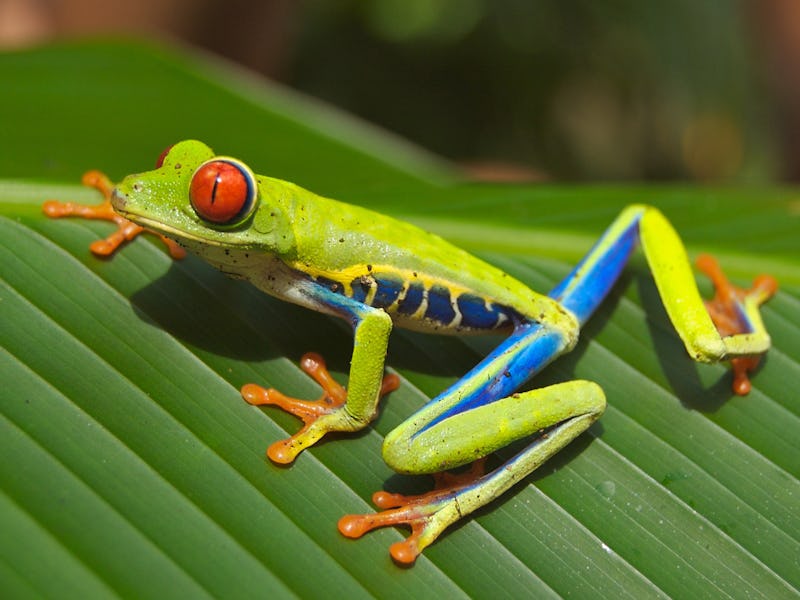Genetic Study Reveals How Frogs Took Over the World
Crisis was their opportunity.

Frogs are amazing animals. They have been on this planet about 100 million years longer than flowers, and have figured out how to make diverse ecosystems their home. Their superpower just might be survival — toughing it out through the worst this planet can throw at them.
And survive they have. New research in the Proceedings of the National Academy of Sciences comes to the surprising conclusion that frogs didn’t just make it through the great extinction event that killed all the non-bird dinosaurs, they thrived in its wake, evolving new species and spreading into new environments.
For frogs, the asteroid impact of 66 million years ago was both crisis and opportunity. Certainly many species would have gone extinct in the harsh aftermath, when the sky went dark from smoke and ash and plants died from lack of sunlight. But those that managed to get through the tough times and see the other side were met with a new world, one in which many ecological niches were newly vacant.
Yan-Jie Feng, a biologist with Sun Yat-Sen University in China, and coauthors found that 88 percent of frog species alive today belong to just three major groups, all of which diversified into many species at the Cretaceous-Paleogene boundary, otherwise known as the dinosaur extinction event. That came as a surprise because earlier studies have dated major frog speciation events to much later. They used molecular clock dating to reconstruct the family trees of living frogs from their DNA, and checked the results against the fossil record.
The Cretaceous-Paleogene (or K-Pg) extinction was certainly devastating. An estimated three-quarters of plant and animal species on land died out. But the ones that got through inherited an empty Earth, and when life got a little bit easier they went forth and multiplied. Small rodent-like mammals were also among the survivors, and they went on to produce humans and all the rest of the mammals on the planet today.
Three major groups of frogs, shown in blue, purple, and green, diversified after the dinosaur extinction.
Humans, though, are likely the biggest threat to frogs since that asteroid punched a hole right through Earth’s crust. Climate change and habitat destruction have been particularly hard on amphibians. By one estimate, 200 frog species have been wiped off the planet in the last few decades, with hundreds more expected to be lost over the coming century.
Frogs are tough, but their porous skin makes them particularly vulnerable to environmental toxins and disease. The invasive chytrid fungus, bolstered by global warming, has been responsible for mass deaths among frogs and amphibians around the world.
History says frogs will probably get through this crisis. They’ve been on this planet a lot longer than we have and there’s a good chance they’ll still be here once we’re gone. The great tragedy of this current, human-caused mass extinction is that the suffering is both extensive and preventable.
Abstract
Frogs (Anura) are one of the most diverse groups of vertebrates and comprise nearly 90% of living amphibian species. Their worldwide distribution and diverse biology make them well-suited for assessing fundamental questions in evolution, ecology, and conservation. However, despite their scientific importance, the evolutionary history and tempo of frog diversification remain poorly understood. By using a molecular dataset of unprecedented size, including 88-kb characters from 95 nuclear genes of 156 frog species, in conjunction with 20 fossil-based calibrations, our analyses result in the most strongly supported phylogeny of all major frog lineages and provide a timescale of frog evolution that suggests much younger divergence times than suggested by earlier studies. Unexpectedly, our divergence-time analyses show that three species-rich clades (Hyloidea, Microhylidae, and Natatanura), which together comprise ∼88% of extant anuran species, simultaneously underwent rapid diversification at the Cretaceous–Paleogene (K–Pg) boundary (KPB). Moreover, anuran families and subfamilies containing arboreal species originated near or after the KPB. These results suggest that the K–Pg mass extinction may have triggered explosive radiations of frogs by creating new ecological opportunities. This phylogeny also reveals relationships such as Microhylidae being sister to all other ranoid frogs and African continental lineages of Natatanura forming a clade that is sister to a clade of Eurasian, Indian, Melanesian, and Malagasy lineages. Biogeographical analyses suggest that the ancestral area of modern frogs was Africa, and their current distribution is largely associated with the breakup of Pangaea and subsequent Gondwanan fragmentation.